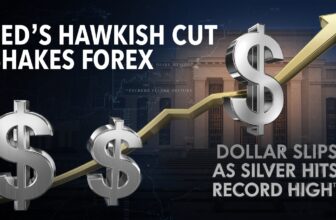
In today’s forex market, while major currency pairs are struggling to make decisive moves, gold continues its impressive uptrend, reaching a new record high. This surge in gold prices comes amid a lack of clear direction for the US Dollar. Investors are closely watching the US economic calendar, which features the weekly Initial Jobless Claims report, and the European Commission’s preliminary Consumer Confidence Index data for February. Later today, several Federal Reserve policymakers are scheduled to deliver speeches, potentially impacting the market further.
US Dollar Price This Week
The table below illustrates the percentage change of the US Dollar (USD) against major currencies this week. Notably, the USD has shown the weakest performance against the Japanese Yen.
| USD | EUR | GBP | JPY | CAD | AUD | NZD | CHF |
|---|---|---|---|---|---|---|---|
| 0% | 0.60% | -0.09% | -1.38% | 0.32% | -0.22% | -0.03% | 0.36% |
This heat map demonstrates the percentage changes of major currencies against each other, providing a clear view of currency dynamics this week.
Market Insights
The minutes from the Fed’s January policy meeting revealed discussions about potentially slowing or pausing the reduction of balance sheet holdings, especially with renewed concerns over the federal debt ceiling. Meanwhile, US President Donald Trump suggested the possibility of a new trade deal with China. Despite these developments, the market reaction was muted, with Wall Street’s main indexes ending slightly higher. As of early Thursday, US stock index futures are trading negatively, and the US Dollar Index remains steady near 107.00 after minor gains over the past two days.
Global Economic Developments
In Australia, the Unemployment Rate edged higher to 4.1% in January from 4% in December, as anticipated. During this period, Full-Time Employment increased by 54.1K after a decline of 23.7K in December. Meanwhile, the People’s Bank of China (PBoC) announced that it would maintain the one-year and five-year Loan Prime Rates at 3.10% and 3.60%, respectively. As a result, AUD/USD saw a slight increase during Asian trading hours, trading above 0.6360.
Currency Pair Movements
EUR/USD has been unable to gather recovery momentum, closing in negative territory for the third consecutive day. The pair remains in a tight range below 1.0450 during the European morning session. Despite stronger-than-expected inflation data from the UK supporting the Pound Sterling, GBP/USD lost traction and closed marginally lower. However, it holds its ground as the European session begins, trading near 1.2600.
Expectations for a hawkish Bank of Japan policy outlook continue to support the Japanese Yen. Earlier, Japan’s 10-year government bond yield reached its highest level in 15 years. At press time, USD/JPY was trading at its lowest level since early December, near 150.00, losing about 1% on the day.
Gold’s Record High
Following Thursday’s volatile market action, gold resumed its uptrend early Thursday, reaching a fresh record high near $2,950. This movement highlights gold’s role as a safe-haven asset during times of economic uncertainty.
Gold FAQs
Why Do People Invest in Gold?
Gold has historically been a key store of value and medium of exchange. Beyond its aesthetic appeal and use in jewelry, gold is seen as a safe-haven asset, making it a popular investment during turbulent times. It also serves as a hedge against inflation and currency depreciation, as it does not rely on any specific issuer or government.
Who Buys the Most Gold?
Central banks are the largest holders of gold. To support their currencies during economic turbulence, they diversify reserves by purchasing gold, which can enhance the perceived strength of their economies and currencies. In 2022, central banks added 1,136 tonnes of gold, worth around $70 billion, to their reserves, marking the highest yearly purchase on record. Emerging economies like China, India, and Turkey are rapidly increasing their gold reserves.
How is Gold Correlated with Other Assets?
Gold typically has an inverse correlation with the US Dollar and US Treasuries, both major reserve and safe-haven assets. When the Dollar depreciates, gold tends to rise, allowing investors and central banks to diversify their assets during turbulent times. Gold also inversely correlates with risk assets; stock market rallies tend to weaken gold prices, while sell-offs in riskier markets often favor gold.
What Does the Price of Gold Depend On?
The price of gold can be influenced by various factors, including geopolitical instability and fears of a recession, which can quickly drive up prices due to its safe-haven status. As a yield-less asset, gold tends to rise with lower interest rates, while higher interest rates usually weigh it down. Most price movements depend on the behavior of the US Dollar, as gold is priced in dollars (XAU/USD). A strong Dollar typically keeps gold prices controlled, whereas a weaker Dollar can push prices up.

















